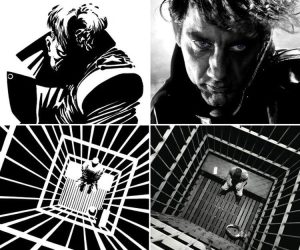Hey everyone,
I first came across McCloud’s work in DTC 354, Digital Storytelling. I couldn’t believe the level of depth contained within comics that McCloud discusses back then, and I’m still contemplating that information to this day.
Time and space are interchangeable within comics. Film, unlike comics, doesn’t typically display all their “frames” at any single moment. We as the viewer can practically experience the entire comic at our own pace, choosing when and where to place our eyes onto any given frame. However, the viewer doesn’t typically spend the same amount of time on each panel depending on its content, and in McCloud’s words, its shape as well. And as McCloud states,
“…the panel shape can make a difference in our perception of time. Even though this (referring to the page 101 with the extended panel in the middle) long panel has the same basic ‘meaning’ as its shorter versions, still it has the feeling of greater length!” (pg. 101).
Does film express its passage of time in the same ways comics do? I would place a yes/no/maybe-so to this question due to a few factors. Firstly, film is really a comic with each panel stacked on top of the other and then displayed one frame at a time on repeat until the last frame appears. In this case, time is passing automatically and the “gutters”, or frame gaps representing time, are absent. The viewer isn’t meant to pause a film just to experience the shot for a longer duration, but to rather experience the shot visually and for its intended duration.
A great example that is a near straight conversion of comic to film envisioning this idea is Sin City from 2005. This film is based on Frank Miller’s comic book series of the same name. The film takes some of the comics wider/longer panels and translates their durations into the film.


Another example of a film that passes time through unique cinematography is 1917. This film was shot with a particular method to appear as a “single take”. While there is a ton of methodology as to how this film was made, one factor remains that pertains to this discussion. 1917 used multiple shots of greater length to make the film appear as one whole piece. The transitions from shot to shot were edited carefully at moments of break, mere seconds in length, that would immediately return to the previous shot such as the camera passing a background element or when characters cross the frame of the camera (DeGuzman).


Film, much like comics, experiment with the perception of time in ways that fit their respective mediums. I will certainly be keeping an eye out in the future for moments like these.
Thanks for reading,
-Caleb
Works Cited:
DeGuzman, Kyle. “How Roger Deakins Shot ‘1917’ to Look like One Take.” StudioBinder, StudioBinder, 1 Feb. 2021, www.studiobinder.com/blog/1917-one-shot-cinematography/.